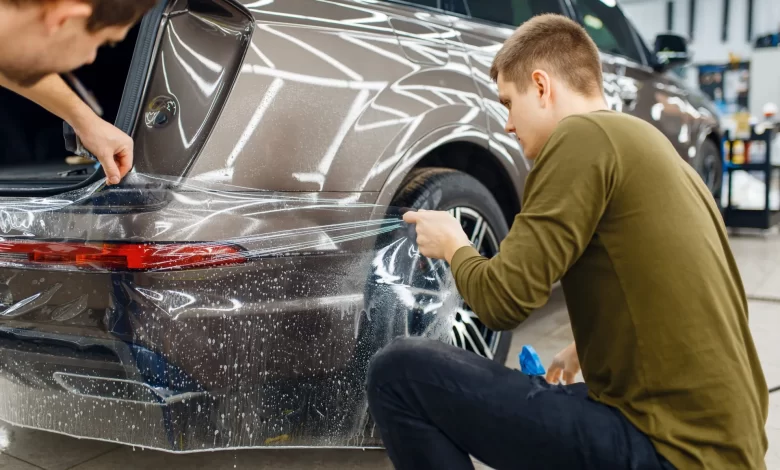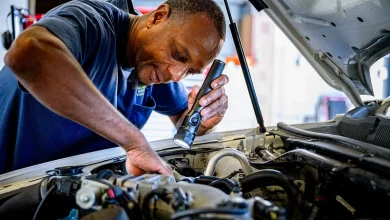Reasons Why You Should Apply A Car Paint Protection Film

Car paint protection film is a must for any car owner. The paint on your car gets scratched and scuffed from road debris, tree sap, and other abrasive elements, which results in unsightly dings and scratches. A paint protection film (PPF) is the perfect solution to this problem.
It offers the level of protection your car needs without compromising on the aesthetics. If you’re interested in learning more about why you should apply a car paint protection film, continue reading for more information.
What Is A Paint Protection Film?
PPF is a thin sheet of plastic that you apply to the paint on your car. It’s a clear sheet that looks almost invisible. Once applied, it creates a protective layer on the surface of your paint that prevents scuffing, scratching, and marring.
It can be used on various surfaces including the outside of your car, the inside of your car’s windows, your car’s door panels, and even the roof of your car.
Because it’s transparent, in most cases, it won’t affect the appearance of your car. PPFs come in different grades, thicknesses, and brands. They protect your paint from UV rays, weathering, and general wear and tear.
They come in a variety of thicknesses, so you can find one that best fits your needs. Some PPFs also have self-cleaning properties, making them easy to maintain.
Benefits Of Car Paint Protection Films
Protects Your Paint – Paint Protection Film creates a protective layer on the paint. It prevents scuffing and scratching, which reduces the chance of paint chips.
Easy To Apply – Paint Protection Film is transparent so it doesn’t affect the appearance of your car. It’s also easy to apply, making it ideal for people with little to no mechanical experience.
Durable – Paint Protection Film is made from strong, durable plastic. It lasts longer than waxes and polishes, making it a more convenient option.
Self-Cleaning – Paint Protection Film has self-cleaning properties. This means it’s easy to maintain. You don’t have to remove and wash the film.
Versatile – Paint Protection Films are waterproof and resistant to acid rain, extreme weather conditions, and road debris.
Affordable – Paint Protection Films are affordable. They last longer than other products, making them a more cost-effective option.
Drawbacks Of Car Paint Protection Films
May Affect The Appearance – Paint Protection Film can look a little dull after a while. If you don’t have the right grade and thickness, it can also have an adverse effect on the appearance of your car.
Needs Regular Cleaning – Like waxes and polishes, PPFs need to be cleaned regularly. This can be a hassle because you’ll also have to wash your car.
Requires Specialized Gear – PPFs are actually applied on your car using a specialized machine. If you don’t have access to one, you’ll have to find a way to apply it yourself. This can be difficult for people without the right mechanical skills.
Choosing A PPF Provider
PPFs are a type of clear scratch protector. This means the grade or thickness of the film you choose is important. If you want your PPF to last as long as possible, you want to go for a strong, durable grade. However, this can often come at a cost.
PPF grades range from UV-protective acrylics to flexible vinyls. Each type has a unique look and feel, but they all offer protection against UV rays, road debris, and weathering.
One thing you can do to make sure you’re getting the best grade possible is to go for a dry film. Dry films are made from acrylics, which are the strongest and most durable. They’re also the most expensive.
How To Apply A PPF?
PPFs are applied to your car using a machine. Dry films are applied by hand, while wet films are applied using a machine. Dry films are the most popular option because they’re more affordable and they require less maintenance than wet PPFs.
PPF providers have their own application instructions, but they usually follow the same process. You start by cleaning your car and removing all dust and debris.
Next, you apply a primer. Primers serve two purposes: they protect the paint and give the film a smooth surface to adhere to. A primer lasts longer than polishes and waxes, making it an ideal option if you want to save money.
A paint protection film is applied after the primer dries. It’s applied using a machine that applies a thin layer of the film. You can finish the application by buffing your car.
Should I put paint protection film on my car?
Paint protection film, also known as clear bra or PPF, is a thin layer of polymer material that is applied to the exterior of a car to protect it from scratches, chips, and other types of damage. The film is designed to absorb the impact of small debris, such as rocks or sand, that can cause damage to the paint finish. But the question remains, should you put paint protection film on your car?
The answer is a resounding yes, especially if you want to maintain the appearance and value of your car. Paint protection film is a great investment that can help protect your car from the harsh elements of the environment. It can also save you money in the long run by preventing costly repairs that would otherwise be required to fix any damage to the paintwork.
While the initial cost of applying paint protection film may seem high, it is important to consider the long-term benefits. PPF can significantly extend the lifespan of your car’s paintwork, and help to maintain its resale value. Additionally, the film is virtually invisible and can be easily removed without damaging the paint underneath.
Final Words:
Protect your car paint with a paint protection film. These films provide the level of protection your vehicle needs without compromising on the aesthetics. They’re easy to apply, durable, and versatile. They can even be self-cleaning, making them easy to maintain.




